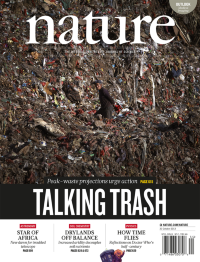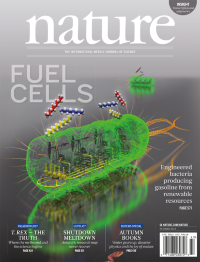Volume 502
-
No. 7473 31 October 2013
Peak waste�, the date when global production of solid waste reaches its maximum, is a useful pointer to the time that humankind will be having its greatest impact on the global environment. Precisely when it will happen is difficult to predict, but writing in a Comment piece in this issue, Daniel Hoornweg, Perinaz Bhada-Tata and Chris Kennedy calculate that on current socioeconomic trends, peak waste will not occur this century. This means that unless we reduce population growth and material consumption rates, the planet will have to bear an increasing waste burden. Hoornweg et al. prescribe population stabilization, better-managed cities consuming fewer resources and greater equity and use of technology as the means to bring peak waste forward. Cover: Nir Elias/REUTERS
Nature Outlook
-
No. 7472 24 October 2013
In the cover graphic, fossil oil production (top) contrasts with the metabolic route. High oil prices and the depletion of fossil resources have fuelled extensive research on the production of sustainable biofuels from renewable resources. Engineered microbes are one option, but until now microbes have not produced gasoline, a mixture of lighter liquid hydrocarbons in the range C4 to C12, in part because cellular metabolism favours the production of mainly long-chain fatty acids and their derivatives. Here Yong Jun Choi and Sang Yup Lee describe Escherichia coli strains engineered to produce short-chain alkanes, free fatty acids, fatty esters and fatty alcohols. The final engineered strain produced as much as 580.8 milligrams per litre of short-chain alkanes, primarily nonane and decane. The metabolic engineering strategies described here should be useful in designing microorganisms for the production of short-chain fatty acids and derivatives as many useful industrial fuels and chemicals. Cover: Yong Jun Choi & Sang Yup Lee
Insight
-
No. 7471 17 October 2013
Every research funding agency wants to support science that makes a difference, but there is no simple formula for identifying truly important research. And as funding gets squeezed, scientists face ever-stiffer competition for resources and jobs, and it becomes even more important to identify the best work. In a series of features and opinion pieces in this issue we examine how the impact of research is measured � and ask whether todays evaluation systems promote the most influential science. Cover by Lorenzo Petrantoni.
Nature Outlook
-
No. 7470 10 October 2013
The protons and neutrons in an atomic nucleus form distinct shells corresponding to large gaps between energy levels, rather like electrons orbiting in an atom. In stable, naturally occurring nuclei, fully occupied shells occur at proton or neutron numbers of 2, 8, 20, 28, 50, 82 or 126 � so-called magic numbers. In unstable nuclei in which a large imbalance of protons and neutrons exists, new shells can appear, others disappear and magic numbers can evolve. A spectroscopic study of the neutron-rich nucleus calcium-54 (20 protons and 34 neutrons) using proton knockout reactions from fast radioactive projectiles generated in RIKENs Radioactive Isotope Beam Factory provides direct evidence that neutron number 34 is magic in this system. This result removes longstanding uncertainty about the existence of such a magic number, and establishes the doubly magic� (in neutron and proton number) nature of exotic calcium-54 isotopes. The cover shows the sodium-iodide detectors used to measure the -rays emitted from excited states of the calcium-54 nuclei. Photo: David Steppenbeck and Satoshi Takeuchi.
Nature Outlook
-
No. 7469 3 October 2013
An artists conception of an erupting supervolcano on Mars blasting massive amounts of ash into the atmosphere (vertical scale exaggerated). Some of the ash would have fallen from the atmosphere to form vast deposits of fine-grained, layered rocks, but some of it would have remained in suspension for years, strongly perturbing the ancient Martian climate. In this issue, Joseph Michalski and Jacob Bleacher report new results suggesting that supervolcanoes existed in the Arabia Terra region of Mars an area with many deposits of layered rocks of unknown origins that has not previously been considered a volcanic terrain. They propose that ancient Martian calderas might have been misinterpreted as impact craters that were degraded by erosion. If supervolcanoes were common on ancient Mars, it would have major implications for estimates of volcanic outgassing, climate evolution and formation of the planets layered, fragmented upper crust. Credit: Mark Garlick.





